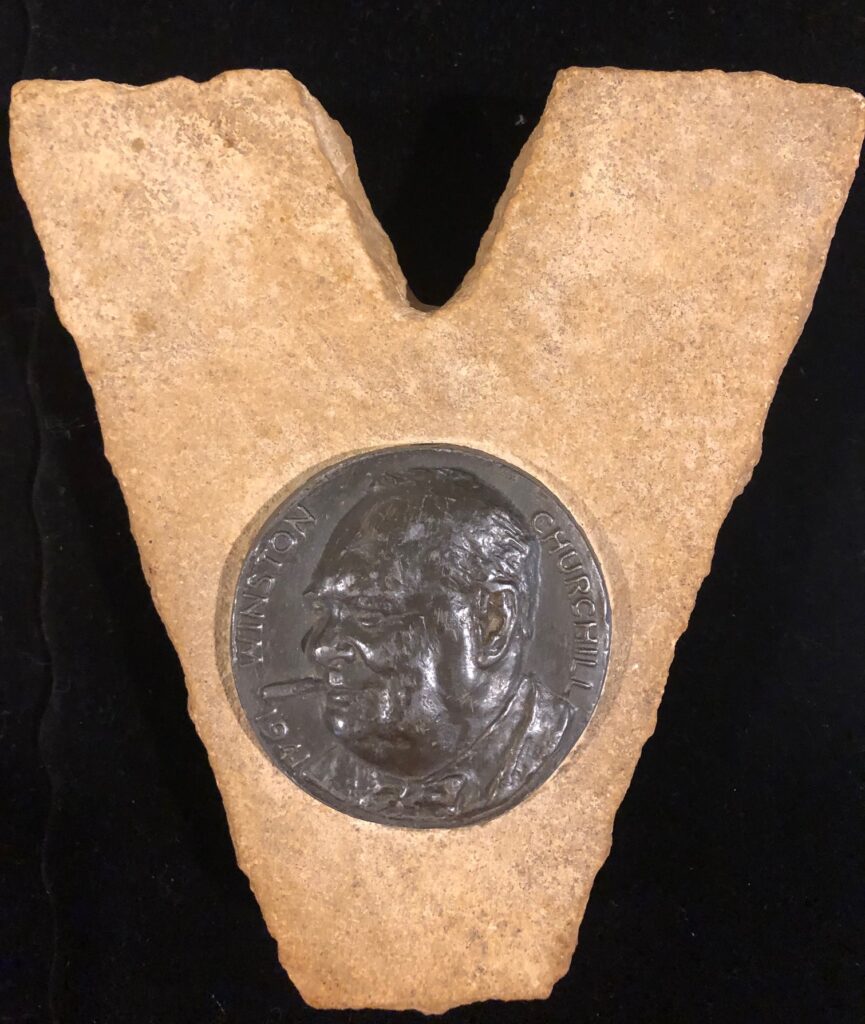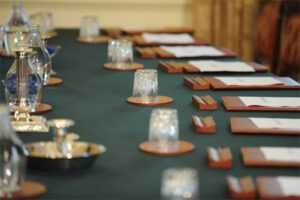
Bulletin #190 — Mar 2024
Churchilliana

To view in full, right click and choose "View Image" or "Open in New Window"; Image: Brian Krapf
February 26, 2024
The World of Churchill Collectables
By BRIAN KRAPF
This month’s item is a World War Two-era Churchill “V”-for-victory souvenir, made from the building stone of the Palace of Westminster. During the Blitz, bombs fell near the Palace of Westminster fifteen times, causing minor damage to the Palace and grounds. As a precaution, both Houses of Parliament convened at Church House in Westminster between 1940 and 1941. The proved to have been a wise move when the Luftwaffe dropped incendiary bombs directly on the Palace on the nights of 10 and 11 May 1941.
The House of Lords chamber sustained an unexploded bomb which entered through the roof and then fell through the floor. Unfortunately, the House of Commons chamber was completely gutted by a fire that spread to the Members’ Lobby and caused the ceiling to collapse. The roof of Westminster Hall was also set ablaze. From June 1941 until October 1950, when the building was fully restored, the House of Commons met in the Lords’ chamber, while the Lords met in the Robing Room. These locations were kept secret until the end of the war.
After 11 May 1941, a question arose as to what to do with the Palace of Westminster’s rubble. These pieces of Britain’s most iconic building could not be discarded. Some suggested the stones represented Britain itself—battered but not beaten. A solution was found. In 1942, a company named London Stonecraft Limited was formed to collect the debris and turn it into useful home and office items. The company produced a sales catalog featuring bookends, letter holders, tobacco jars, paperweights, ashtrays, gardening pots, and even lamps. Each item came with a certificate of authenticity.

2024 International Churchill Conference
Proceeds from the sales benefited the British Red Cross and the St. Johns Ambulance Service. The stone was used to make the actual items, while the lead from the ceilings was melted down and made into medallions affixed to each item. Stonecraft continued manufacturing such products until close to the end of the war in 1945. The object pictured here is one of the more unique as well as one of the first impressions. The lead medallion in the center of the “V” was cast from the ceiling beams of Westminster Hall and features Prime Minister Winston Churchill. The piece is too large and unwieldy to be a paperweight and appears to be more of a tabletop decorative.
The Stonecraft items appear with some regularity in the marketplace and are still very usable. A Stonecraft letter holder on my office desk still serves its purpose. A collector friend uses a Stonecraft tobacco jar. When you see these pieces, you should buy and enjoy them. They are not only collectible, but practical to use.
Brian Krapf’s forthcoming book A Churchill Treasury: Sir Winston’s Public Service through Memorabilia will be published on March 30 in the UK and June 30 in the US.
Subscribe
WANT MORE?
Get the Churchill Bulletin delivered to your inbox once a month.




